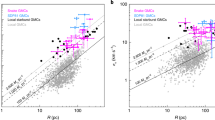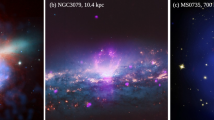Abstract
We present a UV study of 3 extended UV (XUV) galaxies that we have observed with the UVIT and the GMRT. XUV galaxies show filamentary or diffuse star formation well beyond their optical disks, in regions where the disk surface density lies below the threshold for star formation. GALEX observations found that surprisingly 30% of all the nearby spiral galaxies have XUV disks. The XUV galaxies can be broadly classified as Type 1 and Type 2 XUV disks. The Type 1 XUV disks have star formation that is linked to that in their main disk, and the UV emission appears as extended, filamentary spiral arms. The UV luminosity is associated with compact star forming regions along the extended spiral arms. The star formation is probably driven by slow gas accretion from nearby galaxies or the intergalactic medium (IGM). But the Type 2 XUV disks have star formation associated with an outer low luminosity stellar disk that is often truncated near the optical radius of the galaxy. The nature of the stellar disks in Type 2 XUV disks are similar to that of the diffuse stellar disks of low surface brightness galaxies. The star formation in Type 2 XUV disks is thought to be due to rapid gas accretion or gas infall from nearby high velocity clouds (HVCs), interacting galaxies or the IGM. In this paper, we investigate the star formation properties of the XUV regions of two Type 2 galaxies and one mixed XUV type galaxy and compare them with the neutral hydrogen (HI) emisison in their disks. We present preliminary results of our UVIT (FUV and NUV) observations of NGC 2541, NGC 5832 and ESO406-042, as well as GMRT observations of their HI emission. We describe the UV emission morphology, estimate the star formation rates and compare it with the HI distribution in these Type 2 and mixed XUV galaxies.






Similar content being viewed by others
References
Bianchi L. 2011, Astrophys. Space Sci., 335, 51
Bianchi L., Conti A., Shiao B. 2014, Adv. Space Res., 53, 900
Bicalho I. C., Combes F., Rubio, M., Verdugo C., Salome P. 2019, A&A, 623, A66
Bigiel F., Leroy A., Seibert M. et al. 2010, ApJL, 720, L31
Bruzzese S. M., Thilker D. A., Meurer G. R. et al. 2020, MNRAS, 491, 2366
Calzetti D. 2013, in Falcón-Barroso J., Knapen J.-H., eds, Star Formation Rate Indicators, 419
Cook D. O., Dale D. A., Johnson B. D. et al. 2014, MNRAS, 445, 881
Das M. 2013, J. Astrophys. Astr., 34, 19
Das M., McGaugh S. S., Ianjamasimanana R., Schombert J., Dwarakanath K. S. 2020, ApJ, 889, 10
Das M., Sengupta C., Honey M. 2019, ApJ, 871, 197
de Blok W. J. G., Keating K. M., Pisano D. J. et al. 2014, A&A, 569, A68
Dessauges-Zavadsky M., Verdugo C., Combes F., Pfenniger D. 2014, A&A, 566, A147
Ferguson A. M. N., Wyse R. F. G., Gallagher J. S., Hunter D. A. 1998, ApJL, 506, L19
Gil de Paz A., Boissier S., Madore B. F. et al. 2007, ApJS, 173, 185
Honey M., Das M., Ninan J. P., Manoj P. 2016, MNRAS, 462, 2099
Kaczmarek J. F., Wilcots E. M. 2012, AJ, 144, 67
Kataria S. K., Das M. 2018, MNRAS, 475, 1653
Kennicutt Robert C. Jr. 1989, ApJ, 344, 685
Krumholz M. R., McKee C. F. 2008, Nature, 451, 1082
Kumar A., Ghosh S. K., Hutchings J. et al. 2012, in Takahashi T., Murray S. S., den Herder J.-W. A. eds., Society of Photo-Optical Instrumentation Engineers (SPIE) Conference Series, Vol. 8443, Space Telescopes and Instrumentation 2012: Ultraviolet to Gamma Ray, 84431N
Lemonias J. J., Schiminovich D., Thilker D. et al. 2011, ApJ, 733, 74
Martin D. C., Fanson J., Schiminovich D. et al. 2005, ApJL, 619, L1
McGaugh S. S., Schombert J. M., Bothun G. D. 1995, AJ, 109, 2019
Montez Rodolfo J., Ramstedt S., Kastner J. H., Vlemmings W., Sanchez E. 2017, ApJ, 841, 33
Morrissey P., Conrow T., Barlow T. A. et al. 2007, ApJS, 173, 682
Patra N. N., Chengalur J. N., Karachentsev I. D., Kaisin S. S., Begum A. 2016, MNRAS, 456, 2467
Patra N. N., Kanekar N., Chengalur J. N. et al. 2019, MNRAS, 483, 3007
Postma J. E., Leahy D. 2017, PASP, 129, 115002
Rahna P. T., Das M., Murthy J., Gudennavar S. B., Bubbly S. G. 2018, MNRAS, 481, 1212
Rahna P. T., Murthy J., Safonova M. et al. 2017, MNRAS, 471, 3028
Sahu S., Subramaniam A., Simunovic M. et al. 2019, ApJ, 876, 34
Salim S., Rich R. M., Charlot S. et al. 2007, ApJS, 173, 267
Tandon S. N., Subramaniam A., Girish V. et al. 2017, AJ, 154, 128
Tandon S. N., Postma J., Joseph P. et al. 2020, AJ, 159, 158
Thilker D. A., Bianchi L., Boissier S. et al. 2005, ApJL, 619, L79
Thilker D. A., Bianchi L., Meurer G. et al. 2007, ApJS, 173, 538
van der Hulst J. M., van Albada T. S., Sancisi R. 2001, in Hibbard J. E., Rupen M., van Gorkom J. H., eds, Astronomical Society of the Pacific Conference Series, Vol. 240, Gas and Galaxy Evolution, 451
van der Kruit P. C., Searle L. 1981, A&A, 95, 105
Yi S. K., Lee J., Sheen Y.-K. et al. 2011, ApJS, 195, 22
Acknowledgements
The authors gratefully acknowledge the IUSSTF grant JC-014/2017, which enabled the authors MD, NNP, and KSD to visit CWRU and develop the science presented in this paper. This publication uses the data from the UVIT which is part of the AstroSat mission of the Indian Space Research Organisation (ISRO), archived at the Indian Space Science Data Centre (ISSDC). This publication uses UVIT data processed by the payload operations centre at IIA. The UVIT is built in collaboration between IIA, IUCAA, TIFR, ISRO and CSA. The HI observations were done using the GMRT. We thank the staff of the GMRT that made these observations possible. The GMRT is run by the National Centre for Radio Astrophysics of the Tata Institute of Fundamental Research. This research has used Spitzer 3.6 micron images. This research has also made use of the NASA/IPAC Extragalactic Database (NED), which is operated by the Jet Propulsion Laboratory, California Institute of Technology, under contract with the National Aeronautics and Space Administration. The facilities used are Astrosat (UVIT), GALEX, GMRT, WSRT, Spitzer, SDSS, GBT, Parkes.
Author information
Authors and Affiliations
Corresponding author
Additional information
This article is part of the Special Issue on “AstroSat: Five Years in Orbit”.
Rights and permissions
About this article
Cite this article
Das, M., Yadav, J., Patra, N. et al. A comparison of the UV and HI properties of the extended UV (XUV) disk galaxies NGC 2541, NGC 5832 and ESO406-042. J Astrophys Astron 42, 85 (2021). https://doi.org/10.1007/s12036-021-09749-9
Received:
Accepted:
Published:
DOI: https://doi.org/10.1007/s12036-021-09749-9




